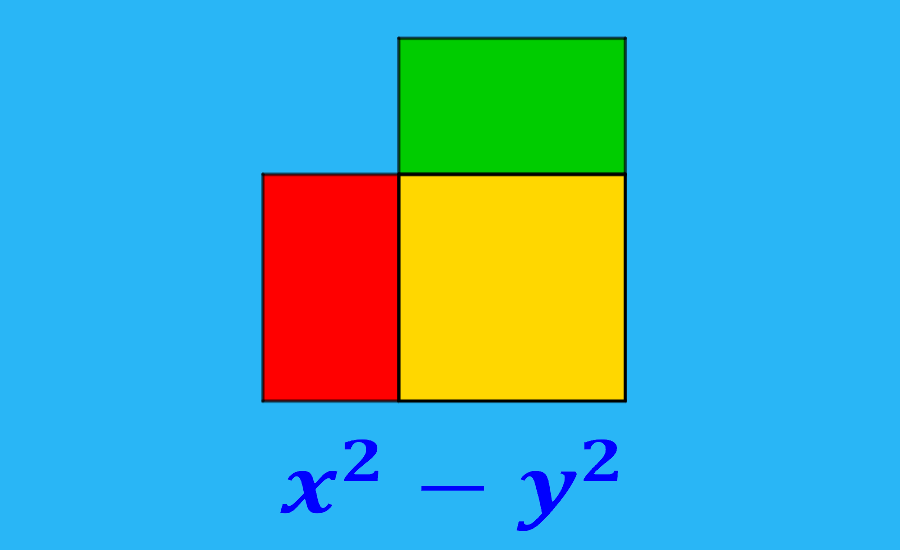To factor a difference of squares, we need to start by applying a square root to both terms of the expression given. Then, we write the algebraic expression as a product of the sum of the terms and a difference of the terms. The difference of squares theorem tells us that if we have an expression of the form a²-b², this is equivalent to (a+b)(a–b).
In this article, we will look at the difference of squares in more detail. We will look at how to factor the difference of squares by using a formula, and we will look at worked-out examples to understand the concepts.
What is the difference of squares?
The difference of two squares is a theorem that tells us that a expression of the form $latex a^2-b^2$ can be written as a product of two binomials, where one shows the difference of the square roots and the other shows the sum of the square roots.
A difference of squares is something that looks like $latex x^2-4$. This is because $latex 2^2=4$, so we actually have $latex x^2-2^2$, which is a difference of squares.
Formula for the difference of squares
The formula for the difference of squares is an algebraic expression that is used to express the difference between two squared values. A difference of squares is expressed in the form:
$latex a^2-b^2$
where the first and last terms are perfect squares.
Factoring the difference of squares, we have:
$latex a^2-b^2=(a+b)(a-b)$
This is true given that $$(a+b)(a-b)=a^2+ab-ab-b^2=a^2-b^2$$
How to factor a difference of squares?
The following are the steps required to factor a difference of squares:
1. Factor the initial expression if possible.
Determine if the terms have a common factor. If so, factor out that common factor, and don’t forget to include it in the final answer. For example, $latex 2x^2-32=2(x^2-16)$.
2. Apply the difference of squares formula.
The formula for the difference of squares is $latex a^2-b^2=(a+b)(a-b)$. For example, $latex 2(x^2-16)$ is equal to $latex 2(x+4)(x-4)$.
3. Factor and simplify the final result.
Determine whether the remaining factors can be further factored or simplified.
Solved examples of the difference of squares
EXAMPLE 1
Factor $latex {{x}^{2}}-9$.
Solution
Step 1: In this case, the expression doesn’t need to be factored.
Step 2: To factor the problem in the form $latex (a+b)(a-b)$ we need to determine the value which we have to square to get $latex {{x}^{2}}$ and the value which we have to square to get 9.
In this case, we have x and 3, since $latex (x)(x)={{x}^{2}}$ and $latex (3)(3)=9$.
$latex {{x}^{2}}-9$
$latex =(x+3)(x-3)$
Step 3: The expression is now in its simplest form.
EXAMPLE 2
Use the difference of squares to factor $latex 4x^2-49$.
Solution
Step 1: The terms don’t have a common factor.
Step 2: To factor the problem in the form $latex (a+b)(a-b)$ we need to determine the value we need to square to get $latex 4x^2$ and the value we need to square to get 49.
In this case, we have 2x and 7 because $latex (2x)(2x)=4x^2$ and $latex (7)(7)=49$.
$latex 4x^2-49$
$latex =(2x+7)(2x-7)$
Step 3: The expression is now in its simplest form.
EXAMPLE 3
Factor the expression $latex 18x^2-98$.
Solution
Step 1: The terms have a common factor:
$latex 2(9x^2-49)$
Step 2: We have to determine the value we need to square to get $latex 9x^2$ and the value we need to square to get 49.
In this case, we have 3x and 7 because $latex (3x)(3x)=3x^2$ and $latex (7)(7)=49$.
$latex 2(9x^2-49)$
$latex =2(3x+7)(3x-7)$
Step 3: The expression is now in its simplest form.
EXAMPLE 4
Use the difference of squares in the expression $latex 4x^2-64$.
Solution
Step 1: The terms have a common factor.
$latex 4(x^2-16)$
Step 2: We have to find the value we need to square to get $latex x^2$ and the value we need to square to get 16.
Therefore, we have x and 4 because $latex (x)(x)=x^2$ and $latex (4)(4)=16$.
$latex 4(x^2-16)$
$latex =4(x+4)(x-4)$
Step 3: The result can no longer be simplified.
EXAMPLE 5
Factor the expression $latex 16x^4-1$.
Solution
Step 1: We have no common factors.
Step 2: We have to find the value we need to square to get $latex 16x^4$ and the value we need to square to get 1.
In this case, we have $latex 4x^2$ and 1 because $latex (4x^2)(4x^2)=16x^4$ and $latex (1)(1)=1$.
$latex (4x^2+1)(4x^2-1)$
Step 3: One of the factors is a difference of squares, so we can factor it: we have to determine the value we need to square to get $latex 4x^2$ and the value we need to square to get 1.
In this case, we have $latex 2x$ and 1 because $latex (2x)(2x)=4x^2$ and $latex (1)(1)=1$.
$latex (4x^2+1)(2x+1)(2x-1)$
If you want to explore more examples of difference of squares, you can visit our article: Difference of Squares – Examples and Practice Problems.
Difference of squares – Practice


Factor the expression $latex 4x^2-36$ using the difference of squares.
Write the answer in the input box.
See also
Interested in learning more about difference of squares and other algebraic topics? Look at these pages:




